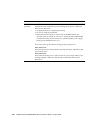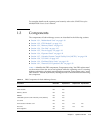
1-4 SPARC Enterprise M4000/M5000 Servers Overview Guide • August 2009
range limits could possibly increase the failure rate of hardware components
significantly. In order to minimize the occurrence of system failure due to
component failure, set temperature and humidity in the optimal ranges.
Note – In order to minimize any chance of downtime due to component failure, use
the optimal temperature and humidity ranges.
Both midrange servers have these features:
■ Rackmountable
■ Support for multiple CPU modules
■ Symmetric multiprocessing (SMP), which is making multiple CPUs available to
complete individual processes simultaneously
■ eXtended System Control Facility Unit (XSCFU)
■ PCI-Express I/O bus
TABLE 1-2 Environmental Requirements
Operating Range Non-Operating Range Optimum
Ambient
temperature
5˚C to 35˚C
(41˚F to 95˚F)
Unpacked:
0˚C to 50˚C (32˚F to 122˚F)
Packed:
-20˚C to 60˚C (-4˚F to 140˚F)
21˚C to 23˚C
(70˚F to 74˚F)
Relative
humidity
*
* There is no condensation regardless of the temperature and humidity.
20% RH to 80% RH to 93% RH 45% RH to 50% RH
Altitude
restriction
†
† All altitudes are above sea level.
3,000 m (10,000 ft) 12,000 m (40, 000 ft)
Temperature
conditions
5˚C to 35˚C (41˚F to 95˚F):
0 m to 500 m (0 ft to 1,640 ft)
5˚C to 33˚C (41˚F to 91.4˚F):
501 m to 1,000 m (1,644 ft to 3,281 ft)
5˚C to 31˚C (41˚ Fto 87.8˚F):
1,001 m to 1,500 m (3,284 ft to 4,921 ft)
5˚C to 29˚C (41˚F to 84.2˚F):
1,501 m to 3,000 m (4,925 ft to 9,843 ft)


















